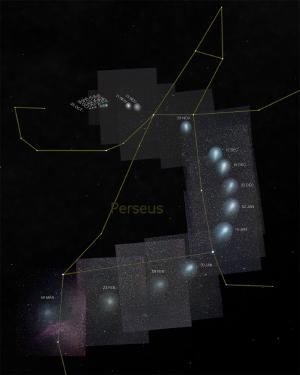Post
A Holmes Mystery
24 October 2013
In October 2007, comet Holmes experienced rapid brightening. By itself this isn’t a huge deal. As comets move closer to the Sun, volatiles (gases and such) can warm and expand, and these can vent out of the comet rapidly, causing the comet to brighten suddenly. Sometimes this out-gassing can cause a comet to fragment, but often it is simply evidence of an active comet.
Comet Holmes was discovered in 1892 by Edwin Holmes (hence the name), and orbits the Sun at a distance between Mars and Jupiter (though tilted a bit from the planetary plane). It is normally rather dim, with a typical apparent magnitude of 17. Holmes wouldn’t have noticed it if it weren’t for the fact that it had brightened to magnitude 5.
 John Pane
John PaneIn 2007 Comet Holmes gained notoriety when it suddenly brightened from magnitude 17 to magnitude 3 in about two days. This made it visible to the naked eye under clear dark skies. The coma (the cloud-like feature surrounding the icy/rocky nucleus) expanded by a factor of four by the end of October, and this once faint object began to look like a traditional comet. You can see this change over time in a composite series of photos showing Comet Holmes from October 2007 to March 2008.
The exact cause of this particular brightening is not entirely clear. The brightening was unusual in just how intense it was. It was so bright that some suggested the comet was struck by a meteoroid, though that would be unlikely. A paper in Astronomy and Astrophysics calculated that the comet lost about 3% of its mass in the event.1 Since the comet didn’t fragment during such a tremendous release of material (Comet Holmes remains intact to this day) the authors suggested a covering of dust coated the comet, under which was a layer of ice. When the ice layer sublimed (when from ice directly to gas) the resulting expansion of gas and dust caused the rapid brightening.
Spectral analysis of Comet Holmes during the outburst, as presented in another paper found not only water, but ethane, methanol and acetylene, which are all rather common hydrocarbons found in space.2 The distribution of various volatile materials is consistent with either the dust layer process or a pocket outgassing. So we aren’t entirely sure what caused the sudden brightening.
Altenhoff, W. J., et al. “Why did Comet 17P/Holmes burst out?-Nucleus splitting or delayed sublimation?.” Astronomy & Astrophysics 495.3 (2009): 975-978. ↩︎
Russo, N. Dello, et al. “The volatile composition of Comet 17P/Holmes after its extraordinary outburst.” The Astrophysical Journal 680.1 (2008): 793. ↩︎